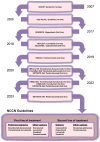MASLD-Related HCC: A Comprehensive Review of the Trends, Pathophysiology, Tumor Microenvironment, Surveillance, and Treatment Options
- PMID: 38921027
- PMCID: PMC11202630
- DOI: 10.3390/cimb46060356
MASLD-Related HCC: A Comprehensive Review of the Trends, Pathophysiology, Tumor Microenvironment, Surveillance, and Treatment Options
Abstract
Hepatocellular carcinoma (HCC) represents a significant burden on global healthcare systems due to its considerable incidence and mortality rates. Recent trends indicate an increase in the worldwide incidence of metabolic dysfunction-associated steatotic liver disease (MASLD) and a shift in the etiology of HCC, with MASLD replacing the hepatitis B virus as the primary contributor to new cases of HCC. MASLD-related HCC exhibits distinct characteristics compared to viral HCC, including unique immune cell profiles resulting in an overall more immunosuppressive or exhausted tumor microenvironment. Furthermore, MASLD-related HCC is frequently identified in older age groups and among individuals with cardiometabolic comorbidities. Additionally, a greater percentage of MASLD-related HCC cases occur in noncirrhotic patients compared to those with viral etiologies, hindering early detection. However, the current clinical practice guidelines lack specific recommendations for the screening of HCC in MASLD patients. The evolving landscape of HCC management offers a spectrum of therapeutic options, ranging from surgical interventions and locoregional therapies to systemic treatments, for patients across various stages of the disease. Despite ongoing debates, the current evidence does not support differences in optimal treatment modalities based on etiology. In this study, we aimed to provide a comprehensive overview of the current literature on the trends, characteristics, clinical implications, and treatment modalities for MASLD-related HCC.
Keywords: MASLD; NAFLD; ablation techniques; hepatectomy; hepatocellular carcinoma; immune checkpoint inhibitors; immunotherapy; liver transplantation; metabolic dysfunction-associated steatotic liver disease; nonalcoholic fatty liver disease; population surveillance; protein kinase inhibitors; tumor microenvironment.
Conflict of interest statement
A.S. (Anwaar Saeed) reports a leadership role with Autem Therapeutics, Exelixis, KAHR Medical, and Bristol-Myers Squibb; consulting or advisory board roles with AstraZeneca, Bristol-Myers Squibb, Merck, Exelixis, Pfizer, Xilio Therapeutics, Taiho, Amgen, Autem Therapeutics, KAHR Medical, and Daiichi Sankyo; institutional research funding from AstraZeneca, Bristol-Myers Squibb, Merck, Clovis, Exelixis, Actuate Therapeutics, the Incyte Corporation, Daiichi Sankyo, Five Prime Therapeutics, Amgen, Innovent Biologics, Dragonfly Therapeutics, Oxford Biotherapeutics, Arcus Therapeutics, and KAHR Medical; and participation as Chair of the Data Safety Monitoring Board for Arcus Therapeutics. The other authors have no relevant financial interests to disclose.
Figures


Similar articles
-
Familial coaggregation of MASLD with hepatocellular carcinoma and adverse liver outcomes: Nationwide multigenerational cohort study.J Hepatol. 2023 Dec;79(6):1374-1384. doi: 10.1016/j.jhep.2023.08.018. Epub 2023 Aug 28. J Hepatol. 2023. PMID: 37647992
-
Phenotypes of Metabolic Dysfunction-Associated Steatotic Liver Disease-Associated Hepatocellular Carcinoma.Clin Gastroenterol Hepatol. 2024 Sep;22(9):1774-1789.e8. doi: 10.1016/j.cgh.2024.03.028. Epub 2024 Apr 10. Clin Gastroenterol Hepatol. 2024. PMID: 38604295 Review.
-
MASLD-related HCC: Multicenter study comparing patients with and without cirrhosis.JHEP Rep. 2024 Jun 29;6(10):101160. doi: 10.1016/j.jhepr.2024.101160. eCollection 2024 Oct. JHEP Rep. 2024. PMID: 39411648 Free PMC article.
-
A review of MASLD-related hepatocellular carcinoma: progress in pathogenesis, early detection, and therapeutic interventions.Front Med (Lausanne). 2024 Jun 4;11:1410668. doi: 10.3389/fmed.2024.1410668. eCollection 2024. Front Med (Lausanne). 2024. PMID: 38895182 Free PMC article. Review.
-
Hepatocellular carcinoma risk prediction and early detection in patients with metabolic dysfunction associated steatotic liver disease.Transl Gastroenterol Hepatol. 2024 Oct 12;9:67. doi: 10.21037/tgh-24-41. eCollection 2024. Transl Gastroenterol Hepatol. 2024. PMID: 39503040 Free PMC article. Review.
Cited by
-
The burden of cancer in metabolic dysfunction-associated steatotic liver disease.Rom J Morphol Embryol. 2024 Oct-Dec;65(4):627-635. doi: 10.47162/RJME.65.4.09. Rom J Morphol Embryol. 2024. PMID: 39957024 Free PMC article. Review.
-
Exploration of the correlation between metabolic dysfunction-associated steatotic liver disease and the FAM19A5 factor: A multivariate linear regression analysis.Medicine (Baltimore). 2025 Jul 11;104(28):e43250. doi: 10.1097/MD.0000000000043250. Medicine (Baltimore). 2025. PMID: 40660539 Free PMC article.
-
Agonists, Antagonists and Receptors of Somatostatin: Pathophysiological and Therapeutical Implications in Neoplasias.Curr Issues Mol Biol. 2024 Sep 2;46(9):9721-9759. doi: 10.3390/cimb46090578. Curr Issues Mol Biol. 2024. PMID: 39329930 Free PMC article. Review.
-
Biomarkers for Immunotherapy Efficacy in Advanced Hepatocellular Carcinoma: A Comprehensive Review.Diagnostics (Basel). 2024 Sep 16;14(18):2054. doi: 10.3390/diagnostics14182054. Diagnostics (Basel). 2024. PMID: 39335733 Free PMC article. Review.
-
Statins decrease the risk of hepatocellular carcinoma in metabolic dysfunction-associated steatotic liver disease: A systematic review and meta-analysis.World J Exp Med. 2024 Dec 20;14(4):98543. doi: 10.5493/wjem.v14.i4.98543. eCollection 2024 Dec 20. World J Exp Med. 2024. PMID: 39713070 Free PMC article.
References
-
- Global Burden of Disease Liver Cancer Collaboration The Burden of Primary Liver Cancer and Underlying Etiologies From 1990 to 2015 at the Global, Regional, and National Level: Results From the Global Burden of Disease Study 2015. JAMA Oncol. 2017;3:1683–1691. doi: 10.1001/jamaoncol.2017.3055. - DOI - PMC - PubMed
-
- Estes C., Anstee Q.M., Arias-Loste M.T., Bantel H., Bellentani S., Caballeria J., Colombo M., Craxi A., Crespo J., Day C.P., et al. Modeling NAFLD disease burden in China, France, Germany, Italy, Japan, Spain, United Kingdom, and United States for the period 2016–2030. J. Hepatol. 2018;69:896–904. doi: 10.1016/j.jhep.2018.05.036. - DOI - PubMed
Publication types
LinkOut - more resources
Full Text Sources

